- Boiler (engine) and Bend patterns needed for Step 4 (or Video Part 7) Do not re-size or “fit to page". Be sure to check the scale.
- For Simple Flat Boat Foam Boat Pattern
- For 3-D Boat
Here are some interesting related pop pop links.
 Perhaps the best, most encompassing web site is the Pop Pop Pages by Vance Bass.
Perhaps the best, most encompassing web site is the Pop Pop Pages by Vance Bass.
Here is a nanotechnology device smaller than an ant that uses propulsion system similar to a pop pop engine, but it uses audio waves instead of a flame as the power source. Here is an amazing video clip of the Acoustic Scallop in motion.
Here is a fascinating site all about steamboats big and small.
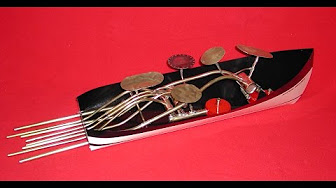
Daryl of Canada is building some magnificent, powerful boats, and I call this his Dr. Suess boat.
Here is a link to a Google translated page a gentleman from Argentina doing interesting research into pop pop engines
Here is the Ponyo movie trailer.
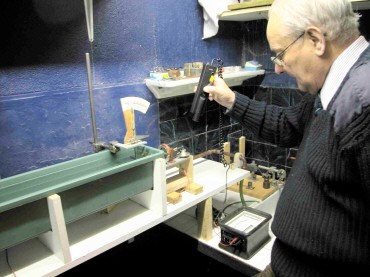
More than a decade had passed when I finally had a good design to share. Alas, Professor Le Bot was elderly by then and the association had become inactive. However, I am fortunate to know another French man who is carrying the torch. He is Jean-Yves, an early-retired marine engineer who is still very active experimenting with pop pops. He is developing apparatus that measures the thrust of various pop pop engine designs, and with that he can calculate total engine efficiency. His English is excellent. Here is a wonderful write-up with pictures of a visit Jean-Yves had with Professor Le Bot. Here is an interesting article he wrote about making a pop pop engine. And here is a really well done article about pop pop engine efficiency.
Although it is written in French, I encourage you to check out the this extraordinary web site eclecticspace.net. (Note: Now the site has an English language option)If you type "eclecticspace.net" into Google, it will offer to translate the page, and it will continue to translate the linked pages. There is a section about pop pop boats, and within that, a section by Jean-Yves. It is my understanding that there is a plan to reprint updated parts of the classic journals mentioned above in the eclecticspace pages--something you might encourage him to do.
Here is a link to a clever PowerPoint holiday card which notes a French saying about not making a ship from an iron...then he precedes to do just that.
Here is a link to a Word document with more activities and pictures.
My family had a wonderful visit from Jean-Yves and his wife in the summer of 2006. It was fun to meet after years of e-mailing!
What other people around the world are doing (and add yours if you send a picture).
My first reaction--because there's so much hoax material on Youtube--was that maybe there's a little candle under the boiler, blocked from view. But looking at other videos on his channel it's pretty clear that this French experimenter is the real deal: a dedicated experimenter.
I have to admit I have a tinge of, "I wish I'd thought of that!"
I was made aware of this and so many other interesting things by Mark, who runs the YouTube channel Resonanttheme. Mark makes the most extrordinary little thermo-kinetic machines--mostly "jumpers" and "rockers". So creative and made from inexpensive consumer products that have absolutly nothing to do with engines, and yet they work!
Pop pop engines with with a single pipe offer particular challenges--particularly getting the water in-- but Paul D. has gotten it to work. Paul reports that, "...the boiler was made from two soldered-together jar lids, in which I soldered a single 4mm copper tube.Since the jar lids are quite large, a candle doesn't provide enough heat. So I use alcohol gel to "sail" this pop-pop. I prime the boiler with a syringe.
Almost all putt putt boats have 2 outlet pipes, but Rob of Brisbane Australia found a rare, single pipe design. I wondered if filling the boiler could be a problem, but Rob wrote,
"I fill the boiler by inserting a length of small diameter nylex tubing down inside the outlet tube, and then run water into the metal tube. The inner nylex then acts as an air release bleeder tube and the boiler fills up. The first expulsions of water and steam seem to push out whatever is excess, and the remainder commences to pulse in the usual Put-put manner. "
Rob replaced the missing cabin and repaired the leaky boiler. We would both like to know more about singe-pipe pop pops! Click on the images for larger view.
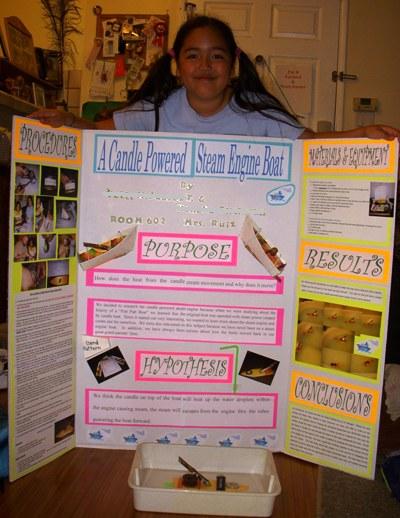
Gabriel from California sent me this wonderful picture of his daughter and her science fair project about pop pop boats. Below, in the tub, you can see the simple foam boat. .
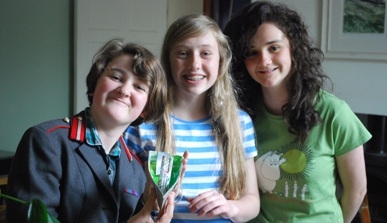
Louisa wrote from England and told me about making putt putt boats with her friends Evie and Rachel. The first engine did not putt, but they were determined to make a working boat. Putt putt boats are challenging and can be frustrating. But for those who are willing work through the problems—and build another if the first doesn’t work—success is sweet. Loisa wrote, "Just 15 minutes ago our boat successfully did 4 laps of my bath before we accidentally blew the candle out with our cheering!"
Young people who do not give up are the ones who make the world a better place. Hats off to these friends who had the grit to rebuild until it worked!
Sometimes I get so wound up with technical details that I forget to have fun, but Gina Thompson’s 8th grade classes in California obviously had fun. Nearly 70 students designed the boats as well as making the engines. People sometimes have trouble sealing where the straws go through the bottom of the boat and into the water. But here her students show great ingenuity, obviating the need for a perfect seal by engineering catamaran pontoon boats. And with such creativity and class!
Melissa Draper in Utah belongs to a home-school co-op, “just a group of homeschool families who get together so their youth can have some good interaction with others and have a chance to learn something from someone besides mom.” She believes that hands-on learning is important, and acts on it with the group of kids whom she works with.
I usually discourage people from using tea candles—not enough heat—but their boat is obviously running just fine. Melissa even made the hull from some tall aluminum cans her husband emptied, epoxied together; although she allows that cartons are safer for kids. Turns out she is a fiber artist, too.
One of the most fun parts of my website hobby is hearing from people and families who make science projects!
Deanne Bishop in Nebraska is another great teacher who challenges her high school students to create hands-on projects that harness science. Here her students made a double engine boat that works well. I don't know if it goes faster, but I suspect that it pulls more than a single engine boat would.
Oregon teacher Mike Lampert's 9th grade students make putt putt boats as part of a way to introduce energy concepts in a hands-on way. This student noticed the soot from the candle (caused by incomplete burning when the flame is close) on the bottom of the steam engine and developed an aluminum sleeve. I like this: how some go to the extra work of providing hands-on learning experiences for their students; and students who look beyond what the assignmen requirest. I think this young person has a bright future.
There's more work, more setup, potentially more mess for teachers who expose thier students hands-on projects like this. I hope that students and administrators appreciate the teachers who rise to this challeng rather than just teach to standardized tests.
Geert-Jan in the Netherlands was looking for a cool project to do at his son's birthday party. Soon he was hooked, making amazing variations. "This is worse then smoking I can not stop (don't worry I don't smoke)." I think he was joking; anyhow, we agreed that it's a nice state of mind. Sometimes my thinking goes a bit rigid. I don't like "tea candles" (first picture) because they don't deliver enough heat, but Geert-Jan added another wick. Geert-Jan liked the sound of boats with up to 4 engines. You can see more boats, his rudder system, etc.(and the cool kids events he holds) here or click a picture. I think the boat with the Canadian flag is a shout out to Daryl Foster, whom we all admire.
Speaking of being hooked, Frederico Quintiero of Argentina sent this picture of his experiments. I know just how it is, almost a fever that consumes! Frederico's picture reminds me of when I was in my innovation mode, engines appeared all over the house. The 5 minute epoxy adhesive used for the engines sets faster when it is warm. So I put the engines on top of the warm rice cooker, to my wife's dismay. Ah, good times!
Daniel Meltzer of New York City wrote, " My family and I were watching "Ponyo" two nights ago, and marvelling over their candle-powered boat. None of us had ever seen a contraption like this, but we could tell that it was based on something real, not Ponyo's magic. So I googled 'Ponyo's boat'and I found your website." Daniel built it with his 6 year old son and below is the bathtub test.
Diego Torres in Mexico built this boat with his 8 years old daughter, below. He has uploaded some cool kite videos on his channel, too.
Hi, Just emailing to say thanks for the instructions, I made the engine and it worked first time (after I fixed a leak during the pressure test). Great job. Decided to go for a catamaran style as I had some foam board laying around, a bit of hot glue and an elastic band and the boat is up and running. Worked fine with a tea light as well, birthday candle probably had more power but the tealight is less hassle to keep in position.Thanks again,
John Carr
Newcastle UK
Here's a double engine boat by Zhiyang TEH
Huu Thang is a 16 year old student inVietnam who started making putt putt boats for school competion. This boat is loud and powerful.
Jill G., a home schooler, and son Leo got theirs working on the first try. They wanted to know more about how it works--simultaniously ejecting water while being replenished. I've added so many rambling odds and ends to these pages that navigation is difficult, but I do have a page that attempts to explain a bit about how the cycle works here.
Dear Mr. Sharrison,
First of all, thank you for this WONDERFUL website and the very clear presentations and instructions that you provide.
I am from Saudi Arabia and I have two boys: Faris 6 and Basel 3. My son Faris is the little scientist in our family. He loves science and really enjoys making projects himself.
We worked on the pop pop steam boat project for a school presentation that Faris had last school semester. We made two engines and two boats (we had to make one for the 3 year old Basel too!). We started by the foam boat and then made the 3D one. Our boats worked perfectly from the first try and that was VERY exciting to all of us. Most importantly, the kids enjoyed working on this project so much and we enjoyed making it with them too :).
Attached are some pictures and a video of the project.Thanks again!!
Best Regards,
Amal Abdo (Faris and Basel's Mother).
Jimmy Conner has been experimenting with putt putt boats and converted one of his hulls to a functioning sail boat. He's also flying walkalong gliders--a bit hit at school--and modifying the talk box. Jimmy has has some interesting videos on his YouTube channel of train models that are powered by live steam and you can really ride them.
Hieu Tran Trung from Vietnam innovated a simple milk box for the hull and a plastic lid for the candle holder.
Here is a well-built boat from Troy Black, who is an avid RC plane builder and sometimes tinkers with RC boats. " This was a nice diversion from the more complex models I usually build and operate and my wife even thought it was "so cute". She never says that about the model airplanes I build."
And following is a cautionary tale from Troy about a drawback of boating on a large pond. "On the last run of the day, the boiler tubes lost their prime in the middle of the pond. It was too far out to retrieve it quickly so I was unable to blow out the candle flame. It continued to heat up, eventually burning the epoxy and setting the cabin on fire. I think the Krylon paint added to the flammability and it became an inferno for about 5 minutes while slowly drifting to
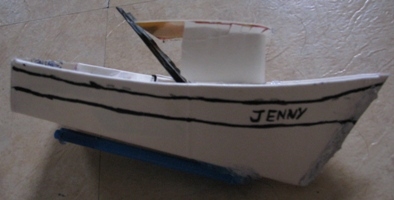
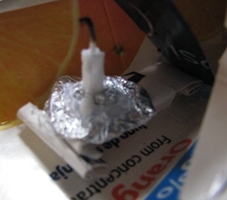
Here is a boat made by Alex Haws, themed after Forrest Gump's shrimp boat, with a candle holder variation.
James Hefner of Texas has been around "live steam" for awhile but liked the idea of making a steam engine with stuff around the home and no soldering. "My son made one for his science project at school. The candle shifted and slightly scorched the roof; but the end result came out fine. He got a 100 for his project, and his was one of three picked to go to a science fair in Dallas. So, it was a big hit."
Here is another Alex, from Texas, who reported that the boat was so loud his mother could heard it from inside. He's been flying the gliders, and his next project is the hot air balloon.
Here's a picture and video sent by Matt Naiva and his son William. Their boat really moves fast!
Here is a picture that Adam and his dad, from England, made. Notice the tire that's been cut in half and filled with water. Great idea! And is that an air rocket launcher I see in the back?
Here is a note and picture of a boat made by some young people in Spain.
Hello. Nice to meet you.
We are two girls, Alba and Rocío, we live in Barcelona (Spain). We are 14 year old and we are studying the put-putt boats for a job in Secondary school.
We liked very much to see your Web. The first thing is to thank you your explication since to do the boat. We have made the boat and enough good works to us. We send a video and photos for you can see it and since it has left to us.
Erin Kermanikian and her son William worked on their boat in little bits after school and work, with William doing as much as he could safely. Now they are thinking about making the boat part out of wood.
Here is a letter and some pictures from Dan Everette and Dan Jr.
Dear Slater:
We did get the engine properly assembled on the first try and have had several good runs with the "putt putt". After a few good experiments in the bath tub we took it out to a local park and tried it in a pond. I have attached 2 photo's for you to enjoy.
Here is a beautiful coil-type pop pop by Mark Horovitz. You can find Mark's instructions here.
Here is a tin version of the boat by Miguel in Madrid. He also made a rudder.
Here is a YouTube video by M.Lemaitre Michel who is a teacher in Belgium, of a pop pop in a pond. Unfortunately, he reports that boat was lost. However, he said that he has others to replace it!
Here is a boat made by Illinois kindergarten teacher Gail and her accountant husband for a 4th of July party.
Here is a picture as well as a video from dad Derek and son Mikey Cook. The video is mostly slides, but there is some kinetic video at the testing phase.
Here's another tin hull from Tony in Victoria, Australia. His region is deep in drought--ponds are dried up, even pools can't be filled--so he faced some challenges testing it. Tony told me his 93 year old father in England made some sort of pop pop from lead electrical sheathing. I'm hoping to get some details from him.
Below is a boat made in 3 evenings by 11 year old Ashton and his dad Grant, in England. Note the modified hull design, the re-formed paper clip in the back to hold the boiler to the right tilt and the "tea candle" burner.
And below is a picture of Clifford and his son's boat with an interesting foam body. Clifford says he plans to experiment with flexible tubes rather than straws.
Here is a picture of a fine boat crafted and sent to me by Mr. Alan Raubenheimer of Rose Boats, PO Box 217, Napier 7270, South Africa.
And here is some fine craftsmanship from John Green of Capetown, South Africa. He relates that he nearly bought a Rose boat (above) and now wishes that he had.
Read "Before You Start Building a Putt Putt Boat" FirstFollow directions exactly when making your first engine!
And don't do anything not in the instructions. Trust me that there are reasons for all the finicky details. --Slater, the sciencetoymaker
If you haven't yet, first watch how to follow the steps in the instructional videos. (Part 2 at 3:29).
All instructions are in video form.
Below are the video links and descriptions to making the kind of toy steam engine boat seen in the movie Ponyo. You can go straight to the instructional video play list, if you want.
Part 1 shows my students testing their boats and gives an overview of the steps involved in making the engine out an aluminum beverage can. I relate where I first encountered pop pops (in South Asia in the 1980's). Then on to a little history: of steam power in general and putt putt boats specifically. Next I show some commercial boats I bought.
I start off relating my efforts to create an easy enough for my students to make, inexpensive steam engine that used common materials that could be found anywhere. Then I make my plea that people follow the directions carefully for the first engine, then experiment.
Part 3 goes through all the materials you will need.
Here is a complete list of materials and tools. Materials and Tools
Note that if you would rather use an oil lamp instead of a candle, excellent oil lamp instructions are here.
Part 4 is Step 1 of the actual building instructions. Are you confused enough? Sorry! The steps are small. This Step 1 is just cutting off the top of an aluminum beverage can.
Cut and trim the middle part of the can so you have a sheet of aluminum to build the engine with.
Fold the aluminum sheet in half, with a thin sliver of the inside of the can showing so it's easier to separate in a later step.
Print out the pattern to actual size (no fitting to page or scaling) and check the scale of the pattern to be sure. Then you tape the pattern onto the aluminum sheet. Save the other boiler pattern and that other weird-looking pattern called the bend pattern. Boiler and Bend Pattern
Cutout the pattern and aluminum on the solid lines--carefully. Save one of the aluminum strips for a later step. Oops, I noticed that the pattern here doesn't have the writing--that's ok, same pattern.
Find a sharp corner, line up the dashed lines with the corner, and make clear fold lines on the dashed lines of the pattern. Your thumbs should be together, and press really hard so you see clear fold lines.
Taking all the pattern/tape off and accurately fold the edge flaps the rest of the way over with a credit card or something like it. Then you need to pound it (not rub it) flat. Be careful not to kink it.
Use a thumbnail to open up the end of the "pocket" a bit, then pinch the end of the long part of a flexible straw and push it in. Then the long part of another straw. Push all the way in, but not so hard them split the other end.
Put one more straw in to form a curved dome top, but this time it's the short end of of a straw. Pinch it and push it in--on the side with the flaps--only to the bendy part. Then put tape donuts on the flat side without the flaps and tape it to a piece of cardboard. Gently push on the edges to make the bottom flat.
Actually glue the aluminum so it keeps its new shape. You should watch the whole step before starting because you only have 5 minutes once you mix the two parts together (less if it's hot). You should have equal parts and mix thoroughly. Dab it on the silver parts even where the silver disappears, especially the ends. It's really important to push the epoxy in between the folds of aluminum with the strip, for strength and to prevent leaks. GOOD NEWS NOT IN THE VIDEO YET: Sticky epoxy is easy to get off with VINIGAR.
Measure 1 1/2" or 39mm from the end of the bendy part of the straws into the small part of the straw. Cut there and apply mixed up, thin, even layer of epoxy to the small part of the straws, but not within 1/4" or 6mm of the bendy part. Put the straws in the end of the aluminum, but only to within 1/4" or 6mm of the bendy part. If a lot of epoxy gets on the bendy part, wipe it off, both above and below.
Be careful when handling the engine and mixing up a tiny bit more epoxy and using it to seal off the 3 or 4 holes where the straws go into the engine.
Take a tip from automotive people and use pressurized air into the straws to find leaks (bubbles in the water). Patch with epoxy and don't pressure test again until it is hard. Use hot water if you need to speed up the epoxy
Make a cardboard angle tool to set the angle between the aluminum boiler and the straws. You saved the pattern that printed out with the boiler pattern way back in part 7, step 4, didn't you?!
Pull the straws longer and tape the angle tool to the boiler and straws. Make sure the folded-over edges are facing outward, not inward against the angle tool.
Use one of the cooler kind of hot glue guns to apply a thin layer of hot glue over the bendy part of the straws, so as stiffen them so they hold the correct angle.
Cut down thin birthday candles into 4 pieces, then make a candle holder out of aluminum foil. It's important to push the aluminum down to the base of the candle, or the candle will go out before burning most of its wax.
Note that a sharp viewer has created some great instructions for making an oil lamp instead of the candle for heat.
You finally get to power test the engine! You don't need a boat to power test the engine. You must prime the straws every time you use the engine. And the first time you use the engine you should slosh some water around inside the engine so the little droplets of water can flash to steam and get your engine going. To start out put the candle flame in the middle between the front and the back of the engine.
Troubleshoot if your engine doesn't work. SKIP THIS SECTION IF YOUR ENGINE WORKS OK. Sometimes you only have to prime the straws with water and try it again and it works. Or maybe you need a more heat if you are using a tea candle (don't use a lighter or you'll ruin the engine). Sometimes there might be a leak even though you already tested it. Still, it's not hard to find it and seal the engine. Sometimes the cause of the trouble remains a mystery and you might just have to make another one (Yep, I know, I thoroughly hate having to do things over too).
Some tips when you're finished using the engine, like wiping off the carbon from the candle. Also, using heat to remove what's left of the candle and affix a new one so it doesn't keep falling out. Now is the time to decide which kind of boat to make for your engine. Instructions for the simple foam boat are in Part 24. But the instructions for the 3D milk carton boat are in Part 27, farther below.
Make a simple flat boat out of a foam grocery tray. It's only held on with rubber bands, so you can move the engine to another boat later if you want. Funny, but it seems you actually have to put some weight to give the engine something to push against or the engine doesn't work well. Foam Pattern
Make the boat go faster by restricting the straws a little at the end, just like real jet engines and rockets. Finally you can tell the control freak (me) to go soak his head, and you can break loose with experiments.
Congratulations and some final words. I depend on feedback to make the instructions better. And frankly, when you get the engine working it's encouraging to me to hear that as well.There is a gallery of pictures of people's pop pop boats that you can add your boat to. Also, now that you have made a boat, be aware that there is a Yahoo group of people from all over the world who experiment and talk about pop pop boats. Some people are just interested in engine development, or scaling up engines, others in making a beautiful boat for the engine, others in the history. There are nice people moderating the group, there is an enormous archive of tips and pictures, there is no money involved, and it's easy to join (if an internet dummy like me can do it, anyone can). And, we are mostly older people, but I think I can speak for the group that we would be thrilled to see the work that younger people are pursuing (and you are still welcome if you are a geezer like the rest of us).
Part 27 is making a 3D hull from a milk or juice carton.
Most of the video is from a video I made for my students years ago. This hull is made from a 1/2 gallon or 2 liter milk or juice carton. That kind of cardboard is waterproof, east to cut, bend, glue and paint. Make sure that when you print the pattern you do not have any box checked that "fits to page" or otherwise changes the scale. After it's cut, it's folded and fastened with staples and hot glue. Hull Pattern
After it's widened you can install the engine. The straws go out a hole in the bottom, so you seal and glue in the engine with hot glue.
If YouTube is blocked at your school, try the SchoolTube equivalents below.
If you want to watch one long video instead of 3 separate parts, you can watch the whole video here.
If blocked, try this SchoolTube equivalent of Part 27A
If YouTube is blocked, here is SchoolTube equivalent
If YouTube is blocked, try this SchoolTube equivalent of Part 27C
I got a wonderful tip about making a rudder for the boat from young Australians Elana (12) and Alex (10) who made putt putt boats with their grandad Les. Click here to see the PDF of the drawing of their ingenious rudder system. Rudder PDF
This too is made from a milk or juice carton. It fits on top of the hull but comes off if you need to get to the engine. The PDF patterns for the deck/cabin assembly are here. (You don't have to make the smoke stack, but the instructions for that are also here if you want to.) Deck and Cabin
A hot glue gun puts all the pieces together.
Here are the YouTube video instructions for making the deck and cabin for the 3 dimensional hull.
Here are the SchoolTube videos.
The Deck and Cabin Part 1
The Deck and Cabin Part 2
The Deck and Cabin Part 3
Now that you've made an engine, hull and deck, check out the work of a true craftsman, my friend Daryl from Canada
Before you start building, understand that this is not a slop-it-together project. You have to follow directions exactly, and, from the feedback I get, most people need to build a second one before it works. I like this e-mail from Jordan:
Mr Slater Harrison,
My name is Jordan and I'm from Greece. I'm 14 years old and I must say that I'm not very good at physics! But, I wanted to make something like a wooden construction so I searched on YouTube and I came up with your video about putt-putt boat! I thought that it was exactly what I wanted to do! Then, I saw all the videos of this boat. It looked so simple but when I started I realized that it wasn't! My first try was a failure... well, I think it was a disaster because in the end my desk was full of epoxy!! My second try was a success! (I have one photo attached) When I saw it working I was very proud of my self!!
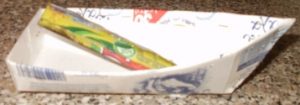
I must say that your site is fantastic and I'm planning to build a plane next time! (I hope that I won't break anything!) ( I will inform you!)
Yours sincerely,
Jordan
Jordan has just the right attitude: keep trying!
And for those who want to take up the challenge of building your own Putt Putt Boat, here are the instructions.
The first time I saw a putt putt (aka pop pop, Ponyo) boat I couldn't believe my eyes! I must have gotten every science toy known to mankind when I was a kid: rockets, airplanes, slinkys, the bird that dunks its head in water, the junior chemistry set that I almost burned down the house with...I could name dozens. But it wasn't until I was an adult that I encountered a putt putt steam boat. It was chugging away in an outdoor market in Bangladesh-- in Southern Asia-- one of the poorest countries in the world. Made mostly from a recycled milk tin, it sounded like a tugboat and it really zipped fast--all powered by a little vegetable oil lamp. How could such a cool thing have existed without my knowing about it? ...Read More>>
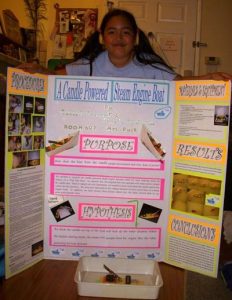
You can see other people’s projects (and add yours if you send a picture) from around the world in the Pop Pop Gallery.

Before you start building, understand that this is not a slop-it-together project.
You can make the body of the boat with a recycled, cut-up milk or juice carton.
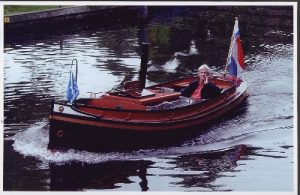
Have you thought about making a giant pop pop boat? You’re not alone–and I mean that in a good way.
I'd like to know how this project goes for you. I'm happy to answer questions about it. Feedback from you is an important way for me to know what works and what needs clarification.
